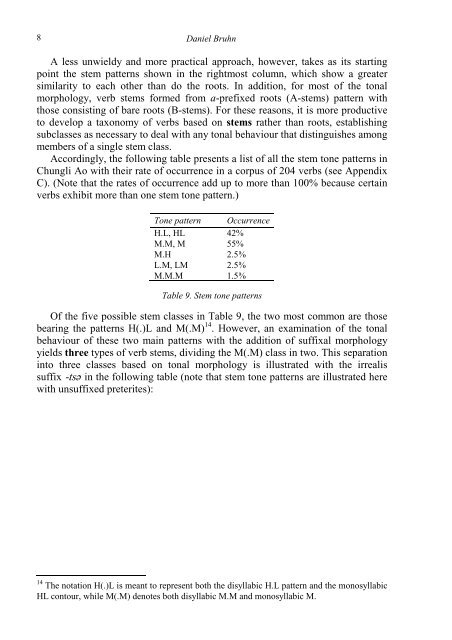A TONAL TAXONOMY OF CHUNGLI AO VERBS Daniel Bruhn ...
A TONAL TAXONOMY OF CHUNGLI AO VERBS Daniel Bruhn ...
A TONAL TAXONOMY OF CHUNGLI AO VERBS Daniel Bruhn ...
You also want an ePaper? Increase the reach of your titles
YUMPU automatically turns print PDFs into web optimized ePapers that Google loves.
8<br />
<strong>Daniel</strong> <strong>Bruhn</strong><br />
A less unwieldy and more practical approach, however, takes as its starting<br />
point the stem patterns shown in the rightmost column, which show a greater<br />
similarity to each other than do the roots. In addition, for most of the tonal<br />
morphology, verb stems formed from a-prefixed roots (A-stems) pattern with<br />
those consisting of bare roots (B-stems). For these reasons, it is more productive<br />
to develop a taxonomy of verbs based on stems rather than roots, establishing<br />
subclasses as necessary to deal with any tonal behaviour that distinguishes among<br />
members of a single stem class.<br />
Accordingly, the following table presents a list of all the stem tone patterns in<br />
Chungli Ao with their rate of occurrence in a corpus of 204 verbs (see Appendix<br />
C). (Note that the rates of occurrence add up to more than 100% because certain<br />
verbs exhibit more than one stem tone pattern.)<br />
Tone pattern Occurrence<br />
H.L, HL 42%<br />
M.M, M 55%<br />
M.H 2.5%<br />
L.M, LM 2.5%<br />
M.M.M 1.5%<br />
Table 9. Stem tone patterns<br />
Of the five possible stem classes in Table 9, the two most common are those<br />
bearing the patterns H(.)L and M(.M) 14 . However, an examination of the tonal<br />
behaviour of these two main patterns with the addition of suffixal morphology<br />
yields three types of verb stems, dividing the M(.M) class in two. This separation<br />
into three classes based on tonal morphology is illustrated with the irrealis<br />
suffix -tsə in the following table (note that stem tone patterns are illustrated here<br />
with unsuffixed preterites):<br />
14 The notation H(.)L is meant to represent both the disyllabic H.L pattern and the monosyllabic<br />
HL contour, while M(.M) denotes both disyllabic M.M and monosyllabic M.

















